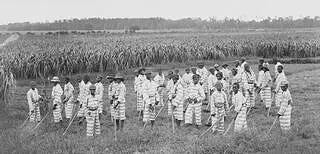On the way out of Houston, to the south, there’s a city called Sugar Land. When my sister picks me up from the airport we always drive by it, but I’ve been there before, too.
Sugar Land is beautiful and eerily perfect, the way Orizaba, Veracruz is eerily perfect. Its facade is so shiny that you just know it’s got to have a sinister past. And it does.
The history of Texas since Anglos showed up has been one of slavery and pain…at least for those not born into the right-colored bodies. Those who occupied the land initially were marginalized and killed, of course, as new arrivals expanded westward. Interest in Texas really grew when people realized they could make a fortune hauling slaves over and forcing them to work on plantations. And that’s what they did, even though they *technically* weren’t allowed. But laws, schmaws. This is big money we’re talking about!

Alas, this did not sit well with abolitionist Mexico, but they just didn’t have enough people that far north to keep things under control, and before they knew it, they had an infestation on their hands of gringos feigning ignorance of Mexican law because they didn’t speak Spanish. They wouldn’t convert to Catholicism, either.
And that’s how white people in Texas decided to put up a real fight for the land, and don’t let anyone tell you otherwise. Texas Independence was about the “freedom” to have slaves and, if you were white, make one’s fortune.
So about Sugar Land. The area initiated as — you guessed it — a sugar plantation. After the abolition of slavery, wealthy Texans were obviously not just going to start treating Black people as equals. Many of those who’d managed to survive under the backbreaking work of slave labor began surviving under the backbreaking work of tenant farmer labor, and I’m sure you can imagine what a great deal that was for them. What does freedom mean, after all, if it comes with zero opportunity?
For a much deeper dive, the book Slavery by Another Name gets deep into the devastating weeds here. But basically, the vast plantation turned into the Imperial Sugar Company, whose bags of sugar can still be found on shelves today. It eventually turned into a “company town,” and in the great American tradition of exploiting the labor of desperate people with no other options and offering little-to-no money for it, the company’s wealth exploded as it operated with “convict lease” labor, basically forcing Black men into jail for literally any reason at all to ensure a steady supply of “workers” for free.
(Above: CCR made this song famous, but it dates back, many believe, to Sugar Land’s earlier days, where the train would go right through the prison labor camp; the superstition was that if one of the train’s lights shone directly into your cell, you’d be freed.)
What’s under Sugar Land? Mass unmarked graves, that’s what.
And yet, the city is beautiful, clean, and functional. It’s diverse. There are museums, restaurants, and the greatest number of planned communities in a county known for its vast number of planned communities. The people in Sugar Land live well.
Most places in the world have a rough past. It’s the nature of life, and of what people do to each other. The creepy thing about Sugar Land, to me, is how willingly that history has been glossed over and ignored, the city a veritable Stepford Wife. But it’s been a while, and most people alive today don’t remember it has anything other than what they’ve known it to be.
Past sins, especially when they were downright institutionalized, are hard to reckon with. I didn’t enslave anyone, after all. Yet I have indeed benefited from being a part of the “right” group by virtue of birth, with all the opportunity and the kind of grace you don’t notice unless you don’t have it that that entails.
What do we owe to the descendants on the wrong side of that unfair past — those who’ve inherited the inequality, born of racism, passed down through generations? Those who might have lived such different lives otherwise?
A couple of weeks ago, I couldn’t believe what I was reading: actual reparations within US borders. Hallelujah!
The spot? Well, certainly not Sugar Land. Tulsa, Oklahoma! You’ve likely read about the Tulsa Race Massacre in 1921, which burned an exceedingly successful “Black Wall Street” to ash, killing up to 300 people.
The new mayor, the city’s first Black mayor, is establishing a trust of $105 million for things like housing assistant and home ownership pushes, restoring Greenwood neighborhood (the one that was burned down), and money for grants for small businesses.
Well, it’s about time for some justice.
It’s hard to recognize hardship without doing anything to make up for it, which I think is why people don’t want to spend too much time recognizing it, because that would entail responsibility. Without actual fixes, it’s just a never-ending series of empty land acknowledgements: “We recognize that this was yours and it was stolen, and we just want to say that we know that and feel bad about it (though there will be no transfers back; it’s been so long and is too complicated now. You understand.).”
“Um…thanks, I guess?”
Will we ever see large-scale reparations? Probably not. Should we try to make things right when we can see a direct connection between historical abuse and current hardship? Yes, definitely.
After all, we all owe our lives to each other.






Another great song that references Texas’ sugar plantation history of slavery: https://youtu.be/t-jN49rQoLI?si=dpVbGnQoEdbI233e
I've always wondered about that place, never having stopped there coming to or going from Mexico. An interesting meditation on history and responsibility. The Germans have done an admirable job in acknowledging guilt for the Holocaust and making reparations. Our collective guilt is buried conveniently in the past and history is what the right wing is at great pains to suppress.